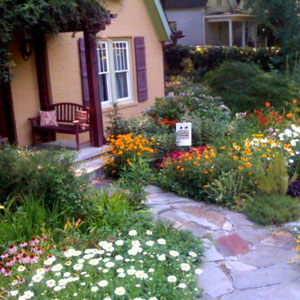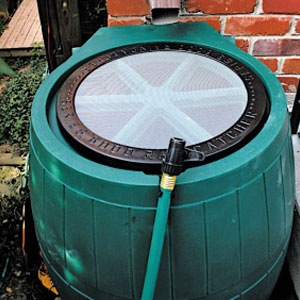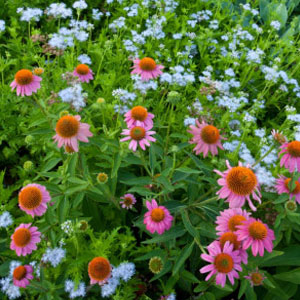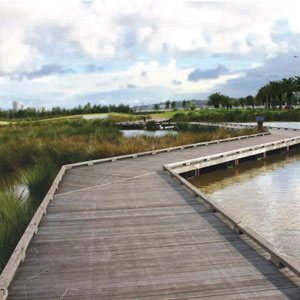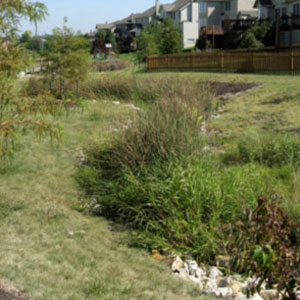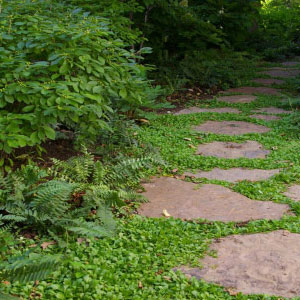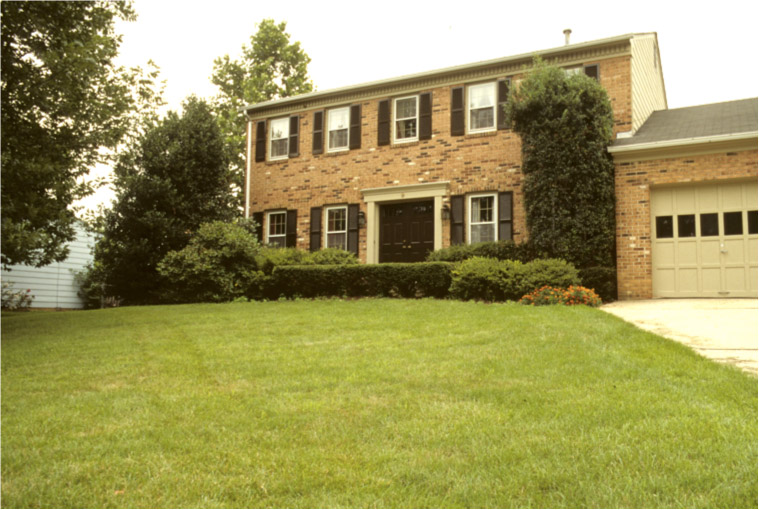
Conventional residential landscape. Image credit: Andy and Sally Wasowski
Avoid Polluting Water Resources
Create a biofiltration garden.
One of the best ways to prevent stormwater runoff in a home landscape is to create biofiltration gardens. Also known as rain gardens or bioswales, these gardens use plants, soils, mulch and microbes to slow and treat stormwater runoff. This management practice is modeled after natural ecosystems and has been shown to effectively reduce heavy metals, nutrients, bacteria, water temperatures and other pollutants. In an ornamental garden, biofiltration areas can be easily integrated into the landscape and filled with a variety of beautiful plants. The gardens hold standing water temporarily and typically drain within 24 to 48 hours. Because water is only held for short periods of time, biofiltration gardens typically do not serve as habitat for mosquitoes (a common concern).
By cleaning stormwater and encouraging infiltration, rain gardens and bioswales provide a variety of benefits:
- Reducing stormwater runoff and the likelihood of flooding
- Protecting local streams and lakes from pollution and physical damage caused by chemicals and debris carried by stormwater
- Increasing the amount of water for your landscape
- Replenishing groundwater supplies
Explore your options.
Rain Gardens
A rain garden is a strategically located low area where water can soak naturally into the soil. Rain gardens can be any size or shape and are easily integrated into your overall landscape. Learn how to create a rain garden here.
Bioswales
Bioswales are shallow vegetated channels that slowly convey and absorb rainwater runoff. They can be used to direct surface runoff to rain gardens or other areas of the landscape where water can be absorbed. Bioswales can be woven into the garden and vegetated with a variety of trees, shrubs and perennial plants. The longitudinal slope of a bioswale typically ranges from one to six percent. Decorative rocks, check dams and vegetation can be used to control and slow the velocity of water moving through the channel. Similar to rain gardens, bioswales typically have three wetness zones. In the lowest zone, plant species should be selected that can tolerate short periods of standing water as well as fluctuating water levels and dry conditions. In the middle zone, vegetation will need to tolerate both wet and dry conditions. And in the upper zone, along the outer edges of the bioswale, plants should be suited to drier conditions.
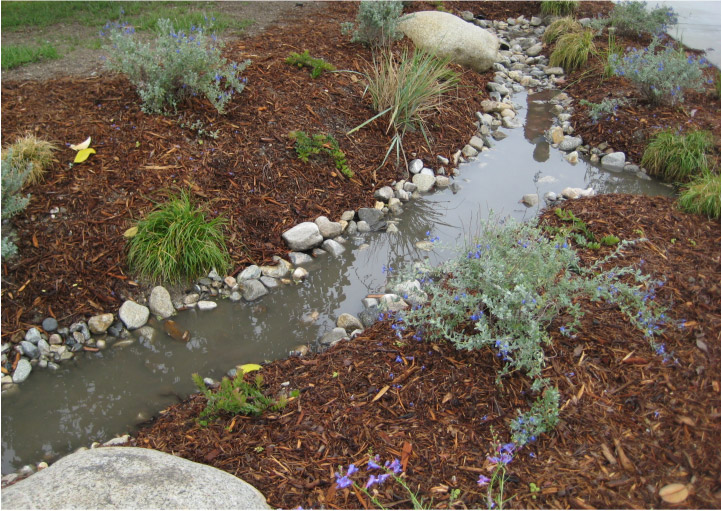
Newly planted bioswale after a rain event. Image credit: Los Angeles and San Gabriel Rivers Watershed Council
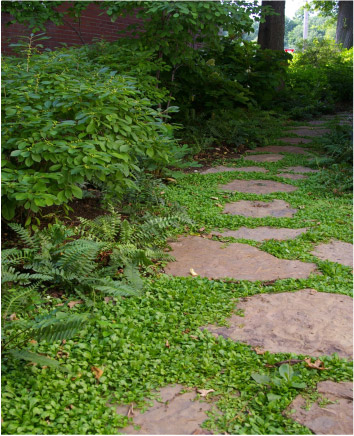
Stepping stones allow vegetation to grow around and in between them, thus limiting the impervious surface of the walkway. Image credit: SWT Design
Limit impervious surfaces.
Impervious surfaces are typically constructed surfaces — rooftops, sidewalks, driveways, roads — covered by impenetrable materials such as concrete, blacktop, and mortared brick or stone. But urban and suburban soils, which are often compacted by intense foot traffic or construction equipment, can also be highly impermeable. As urbanization increases, so does the amount of impervious surface. Studies have shown that the quality of many urban watersheds is correlated to the amount of impervious cover in the watershed. Because they prevent precipitation from seeping down into the soil, impervious surfaces are a primary cause of elevated stormwater runoff. Torrents of destructive runoff are generated as rainfall strikes rooftops and pours into gutters and downspouts, picking up volume, speed and pollutants as it rushes over paved surfaces and into storm drains.
Homeowner strategies to reduce impervious surfaces:
- Construct two-track driveways and service roads with a center strip of vegetation or other permeable surface.
- Use stepping stones surrounded by creeping groundcovers instead of continuous impermeable pathways.
- Opt for “dry laid” instead of “wet laid” or mortared patios and walkways. Set in sand, these allow some stormwater to infiltrate into the soil, unlike the cement products typically used as mortar.
- Allow green spaces between patios, pathways and other impermeable spaces
- Restore the ability of soils to absorb rainfall and take steps to prevent soil compaction elsewhere in the landscape.
- Consider permeable paving, such as concrete products with a porous structure that allow water to pass directly through the surface.

